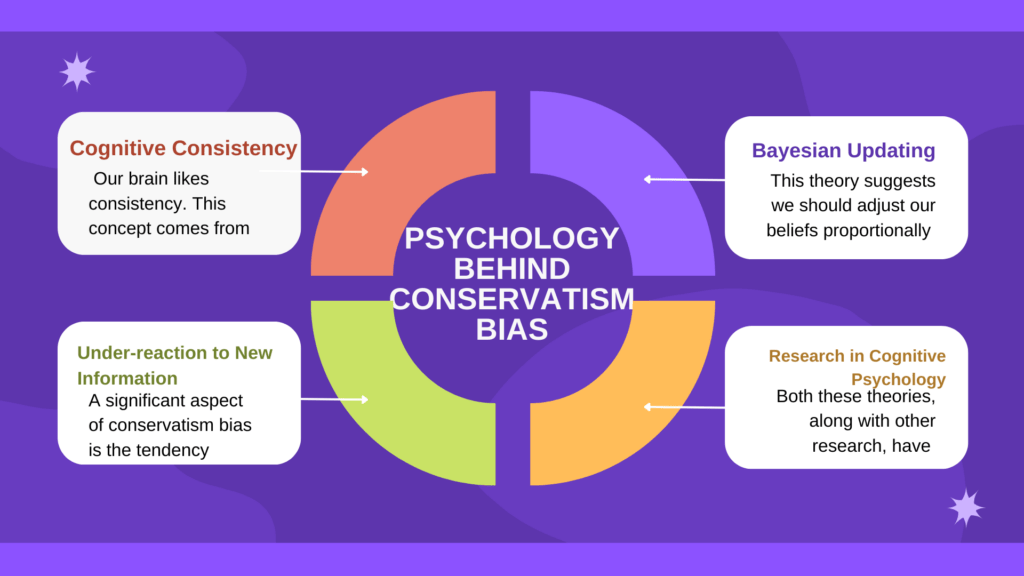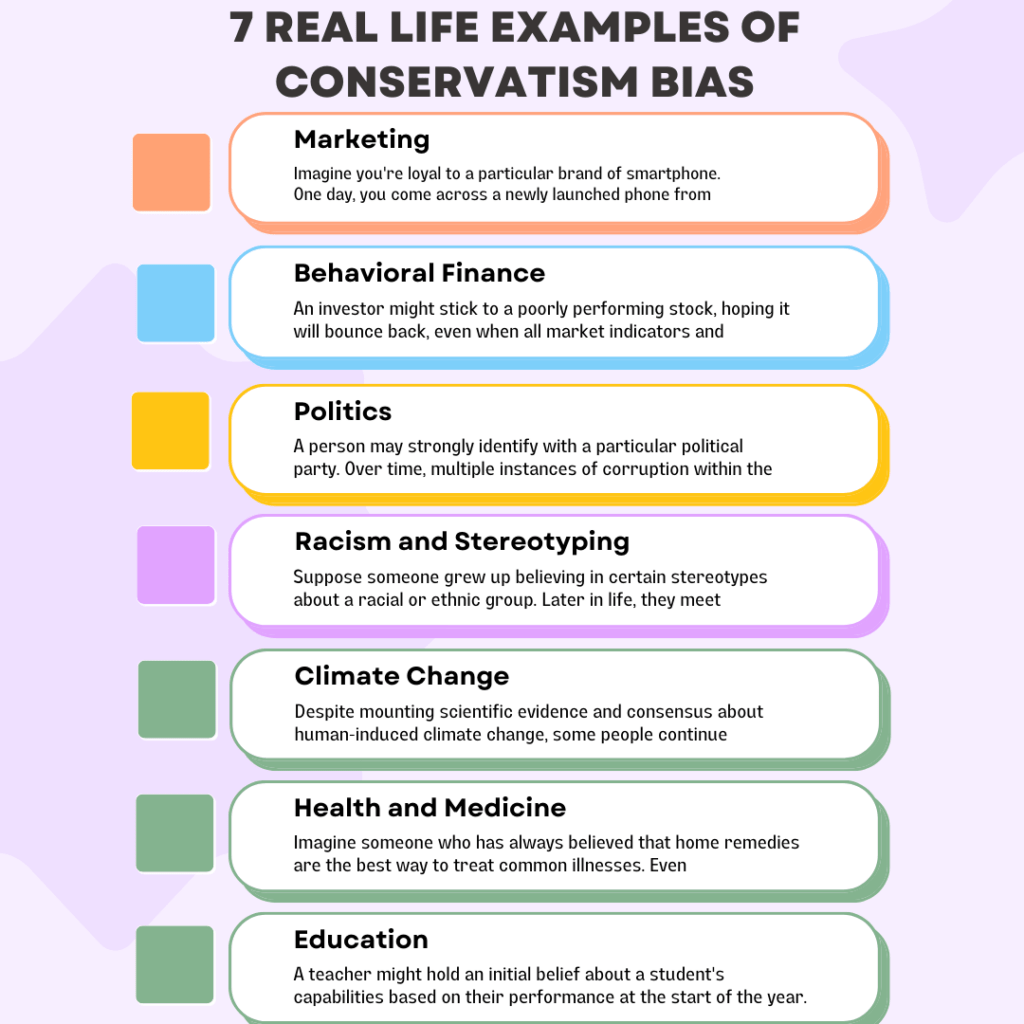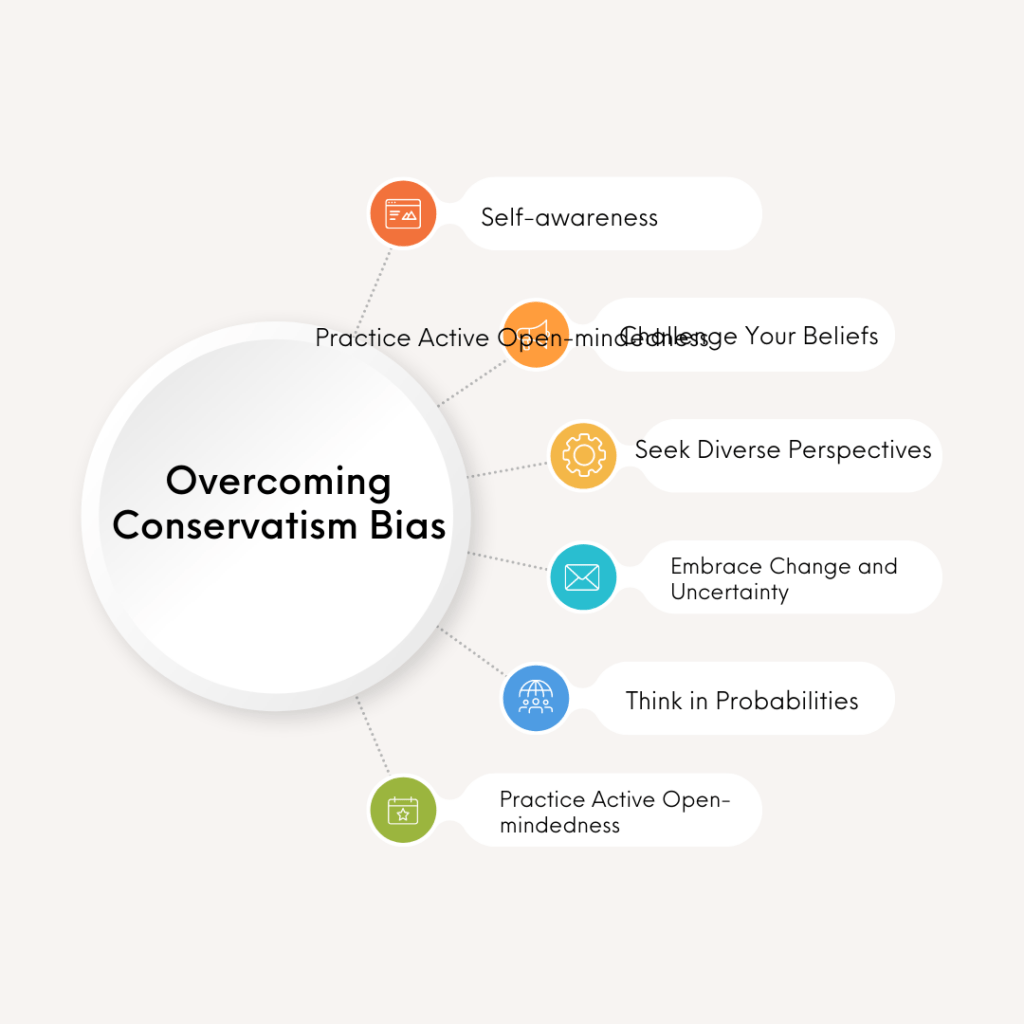Alright, so let’s chat about this fascinating thing called conservatism bias. Ever found yourself clinging to your initial beliefs, even when fresh info comes along that should totally change your mind? That’s exactly what we’re talking about. It’s a mental shortcut we all use – an autopilot setting that tells us to stick with what we know, even when we should probably be switching things up.
Now, you might be thinking “So what? Isn’t it normal to hold onto what we believe?” And sure, you’re not wrong. But here’s the twist – this stick-to-what-you-know approach can sometimes steer us wrong. It can make us overlook new ideas, miss out on opportunities, and even make some pretty sketchy decisions. So, while conservatism bias is a part of being human, it’s also something that’s really worth understanding, because once we do, we can start making smarter choices. So, buckle up, because we’re about to take a deep dive into this intriguing world of conservatism bias.
Definition of Conservatism Bias
Conservatism bias, in simple terms, is when we favor prior evidence over new evidence that has come to light. It’s the tendency to underreact to new information, meaning we hold onto our existing beliefs or forecasts too strongly even when presented with new, substantial evidence. In other words, it’s our mind’s way of saying, “I like what I already know, and I’m not quite ready to change my views.” Pretty interesting, isn’t it.
Psychology Behind Conservatism Bias

Cognitive Consistency: Our brain likes consistency. This concept comes from the theory of cognitive dissonance, proposed by Leon Festinger. Essentially, when new information conflicts with our existing beliefs, it creates an uncomfortable state (cognitive dissonance). To reduce this, we often underplay the new information and stick to our original beliefs.
Bayesian Updating: This theory suggests we should adjust our beliefs proportionally when faced with new information, a concept from Bayesian statistics. However, in practice, people often don’t adjust enough, demonstrating conservatism bias.
Under-reaction to New Information: A significant aspect of conservatism bias is the tendency to underreact to new evidence, essentially giving it less weight than it deserves compared to our established beliefs.
Research in Cognitive Psychology: Both these theories, along with other research, have deepened our understanding of how conservatism bias impacts our decision-making. It’s shown to affect various areas of life, from financial decisions to social judgments.
7 Real Life Examples of Conservatism Bias

Marketing
Imagine you’re loyal to a particular brand of smartphone. One day, you come across a newly launched phone from a different brand that has superior features and excellent reviews. Despite this new information, you still opt for your usual brand during your next upgrade, underweighing the significance of the new information. This is conservatism bias at play.
Behavioral Finance
An investor might stick to a poorly performing stock, hoping it will bounce back, even when all market indicators and financial analyses suggest it’s time to sell. Their initial belief in the stock’s potential blinds them to new evidence, showcasing conservatism bias.
Politics
A person may strongly identify with a particular political party. Over time, multiple instances of corruption within the party come to light. Despite this, the person continues to support the party because their initial belief (that the party represents their views best) outweighs the new contrary evidence.
Racism and Stereotyping
Suppose someone grew up believing in certain stereotypes about a racial or ethnic group. Later in life, they meet individuals from that group who don’t conform to these stereotypes, but they still find it hard to let go of their initial beliefs. This too is an example of conservatism bias, where prior biases and stereotypes hold sway despite new experiences and information.
Climate Change
Despite mounting scientific evidence and consensus about human-induced climate change, some people continue to believe it’s a natural occurrence or a hoax. Their initial beliefs persist, downplaying new information – a classic case of conservatism bias.
Health and Medicine
Imagine someone who has always believed that home remedies are the best way to treat common illnesses. Even after reading various medical articles promoting the effectiveness of certain medications, they stick to their original belief, again demonstrating conservatism bias.
Education
A teacher might hold an initial belief about a student’s capabilities based on their performance at the start of the year. Even if the student’s performance improves drastically as the year progresses, the teacher may still hold onto their initial belief and not acknowledge the student’s improvement, exhibiting conservatism bias.
How Does the conservatism bias helps to explain the post-earnings price drift anomaly?
The post-earnings announcement drift (PEAD) is a well-documented phenomenon in finance, where a stock’s price continues to drift in the direction of an earnings surprise (either positive or negative) for several weeks (or even months) following the initial announcement.
Here’s how conservatism bias might help explain this:
Underreaction to New Information: When a company announces its earnings, it’s a major piece of new information that investors can use to reassess the value of the company’s stock. However, because of conservatism bias, investors might underreact to this new information. They might not fully incorporate the implications of the earnings surprise into their valuation of the stock.
Delayed Response: As a result of this underreaction, the stock’s price doesn’t immediately adjust to fully reflect the new earnings information. Instead, it gradually “drifts” towards its new fair value over an extended period, as investors slowly update their beliefs and expectations.
Sustained Impact: This can lead to the observed sustained impact of the earnings announcement, where the stock’s price continues to move in the direction of the earnings surprise for some time after the announcement.
In essence, conservatism bias can cause a lag in the market’s response to new information, which in turn can lead to anomalies like the post-earnings announcement drift. It’s worth noting that while conservatism bias provides one possible explanation for PEAD, it’s a complex phenomenon and likely influenced by a variety of factors.
Overcoming Conservatism Bias
Overcoming conservatism bias might seem challenging, given it’s so deeply ingrained in our cognitive processes, but with conscious effort, it’s certainly possible. Here are a few strategies you could consider:

Self-awareness: The first step is to be aware that conservatism bias exists. Simply knowing about this bias can make you more conscious of its potential influence over your decision-making.
Challenge Your Beliefs: Regularly question your beliefs and assumptions, especially when presented with new information. It’s important to deliberately consider and weigh new evidence, rather than defaulting to established viewpoints.
Seek Diverse Perspectives: Encourage different viewpoints and consider contrarian opinions. This can help break the cycle of reaffirming your existing beliefs.
Embrace Change and Uncertainty: Recognize that change is a part of life, and that holding onto old beliefs simply because they’re familiar can limit growth and progress.
Think in Probabilities: Instead of thinking in absolutes (“This is right, that is wrong”), consider the probability of different outcomes. This can help you become more comfortable with adjusting your beliefs.
Practice Active Open-mindedness: This involves deliberately maintaining an open mind and being receptive to new information. It also means acknowledging and reducing the influence of biases on your judgment.
Conclusion
In wrapping up, let’s remember that conservatism bias, like all cognitive biases, is a natural part of being human. It’s a little hiccup in our decision-making processes that often leads us to favor the familiar and resist change. But by acknowledging its presence, staying open to new information, and actively questioning our beliefs, we can keep this bias in check. After all, it’s in embracing change and growing with it that we truly learn, evolve, and make the most of the opportunities life presents
Samrat is a Delhi-based MBA from the Indian Institute of Management. He is a Strategy, AI, and Marketing Enthusiast and passionately writes about core and emerging topics in Management studies. Reach out to his LinkedIn for a discussion or follow his Quora Page
